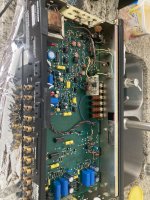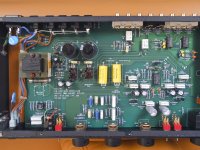No, I use tantalums of today in SMD and haven't had 1 failing. The tantalum/niobium/polymer combined ones simply are good. Ready made devices are full of them. Quite reluctant with the drop type TH tantalums as exactly those used to be very unreliable. I know today's series are good but I already had to learn to trust them again. Many are persistent and never use tantalum caps and they always replace old ones good or bad.
I have 2 Hafler Iris preamp and in both, the tantalum caps failed,
Is this good advice ?
"typically use higher voltage rated tantalum caps. If the original Tantalums were 25V then I go with a 35V rated cap in the same capacitance value. Some people will advocate for installing modern low ESR electrolytics. My theory on this is that if the original tantalum's made it 30years then the higher voltage rated tantalums should last as long or longer and I'll probably not be around by then.
The tantalum caps in the Iris are for PS decoupling in most areas around the IC's and for bypassing in the audio circuit. Tantalum caps are great in that they have very low resistance at high frequencies, they just suck in the fact that they will eventually fail and when they do they short out."
Is this good advice ?
"typically use higher voltage rated tantalum caps. If the original Tantalums were 25V then I go with a 35V rated cap in the same capacitance value. Some people will advocate for installing modern low ESR electrolytics. My theory on this is that if the original tantalum's made it 30years then the higher voltage rated tantalums should last as long or longer and I'll probably not be around by then.
The tantalum caps in the Iris are for PS decoupling in most areas around the IC's and for bypassing in the audio circuit. Tantalum caps are great in that they have very low resistance at high frequencies, they just suck in the fact that they will eventually fail and when they do they short out."
That is exactly where the notorious unreliable drop type tantalum caps used to fail: when used directly on power rails for decoupling. I would use Kyocera AVX TPS series for that today. Or similar quality in TH version.
Don't know the Hafler brand and the Iris device. Advice is to used highest possible voltage rating in the same physical dimensions as: A. it won't hurt and B. you have confirmation that they will have a long service life.
Don't know the Hafler brand and the Iris device. Advice is to used highest possible voltage rating in the same physical dimensions as: A. it won't hurt and B. you have confirmation that they will have a long service life.
At first sight on my phones screen: only a few.
I have never seen that device on my bench. 0 Experience means high error margin.
However I do notice silver mica caps, mediocre quality IC sockets and LDR based volume control.
I have never seen that device on my bench. 0 Experience means high error margin.
However I do notice silver mica caps, mediocre quality IC sockets and LDR based volume control.
Last edited:
7.How many do you see in the preamp ?
I see 7 total, all through hole tear drop types. You have identified all of them.How many do you see in the preamp ?
Who make the best tantalum caps ?
what type are the best ?
many options here
what type are the best ?
many options here
- Tantalum Capacitors - Polymer (8,723)
- Tantalum Capacitors - Solid Leaded (12,896)
- Tantalum Capacitors - Solid SMD (40,305)
- Tantalum Capacitors - Wet (1,982)
That is up to you to decide, it is your preamp they will be used in.
I would choose the rare solid aluminium caps anytime above all the mentioned caps. One of the few cap types that tolerate reverse voltages.
I would choose the rare solid aluminium caps anytime above all the mentioned caps. One of the few cap types that tolerate reverse voltages.
Last edited:
Nope, they are tants.the dark brown dipped types could also be film caps.
<bored this morning>
Quick look, might have double counted or such:
3 Ceramic
2 Dipped Mica
13 Dipped radial film
15 Axial film
9 Electrolytic
Quick look, might have double counted or such:
3 Ceramic
2 Dipped Mica
13 Dipped radial film
15 Axial film
9 Electrolytic
Probably the top two brands are Kemet & Vishay. Panasonic & Kyocera also make quality units but they don't have as extensive selection as the first two. Basically, as with any other component, stick with a top manufacturer from a reputable supply house - Mouser, Digi Key and such. For tantalums used across power rails, make sure the voltage rating is at least twice the rail voltage; for ones used elsewhere it is not as important - just at least match what they have. With the price of tantalums it is often a good choice to replace them with Polymer capacitors - although, as always, check the circuit and make sure there aren't factors that also need to be considered. For example, tantalums are often used for the smaller size and somewhat reduced ESR compared to a standard electrolytic - substituting a polymer in some cases (such as after a regulator) can cause instability because the ESR is too low. Too many people think that ESR is always something evil but it actually serves a purpose in many instances (and the circuit you are replacing it in may have been designed around a component with specific parasitics.)Who make the best tantalum caps ?
Hal
Are talking about regular capacitors ?That is up to you to decide, it is your preamp they will be used in.
I would choose the rare solid aluminium caps anytime above all the mentioned caps. One of the few cap types that tolerate reverse voltages.
https://www.mouser.com/c/passive-components/capacitors/aluminum-electrolytic-capacitors/
Just curious, but why would that be a concern in anything other than a (very) badly designed circuit? Not arguing, just trying to understand why that would even be a recommendation and wondering if there is something I'm missing.I would choose the rare solid aluminium caps anytime above all the mentioned caps. One of the few cap types that tolerate reverse voltages.
Not. I just use the best parts I stock. As said I don’t know the device but I would use the best I have in a device that is worth it.
Got another Hafler preamp the 915, I see more than a few film caps, can you guys ID them ?
musical concepts caps ? are those polypropylene ?
what about the square white caps "CFP", what are those, film caps ?
C19, C16, C116 are those polyester ?
musical concepts caps ? are those polypropylene ?
what about the square white caps "CFP", what are those, film caps ?
C19, C16, C116 are those polyester ?
Attachments
- Home
- Design & Build
- Parts
- solid alu & tantalum caps: replace?

